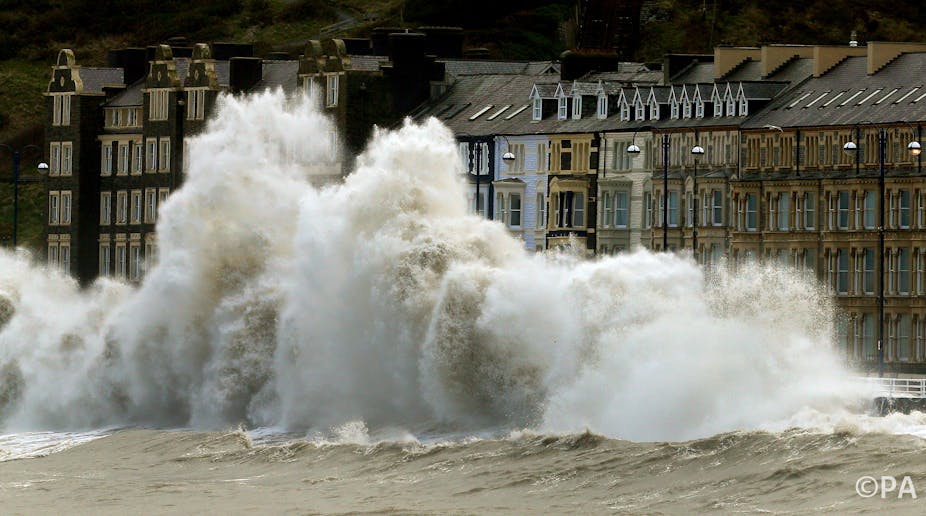“Born on a perilous rock” is the title of a classic book by W J Lewis which describes Aberystwyth past and present; last weekend the town fully lived up to this description. To all intents and purposes, 3 January started as a normal mid-winter day in Aberystwyth with a gale howling in off the sea and spectacular waves crashing off the sea front. Most of the university had extended the Christmas vacation to have a few more days’ rest and less that 150 of the 700 plus students who live in our sea front halls had returned to prepare for their exams.
That it was going to be an unusual evening became apparent when John received a call from his mother-in-law, living in sheltered accommodation by the harbour, saying she was being asked to leave because of the storm. At much the same time Rebecca received a call saying Ceredigion County Council workers were trying to deliver leaflets by hand to all student residences, advising their occupants that evacuate the promenade at least one hour before the high tide at 9.11pm.
How does one evacuate numerous buildings in darkness in the teeth of a storm on a midwinter night and transport people to a place of safety? The answer was to intercept the leaflets and set off the fire alarms in each building in turn, advising the assembled residents to prepare a bag of essentials to be ready to be taken to the main campus. Transport was by requisitioning the small fleet of minibuses owned by the student unions and directing the students to a central place, in a street behind the sea front and from there to the Penglais Campus, several hundred feet above sea level, where we opened up our main refectory and fed and watered our evacuees.
By 8.45pm the evacuation was complete. Having taught and researched hazard management for 20 years John had the opportunity to put theory into practice as it was apparent that his research field had come to him. It was clear we had to make a number of decisions.
When could our students return to their halls? This was straightforward, once National Resources Wales issued this advice and when we had checked our buildings we transported our students back to their halls at 1.30am.
Had the risk of spring tide coupled with storm surge diminished? No. The weather forecast predicted a number of storm events coupled with high tides through to the morning of the 7th.
Was travel to Aberystwyth easy? No, the transport infrastructure was breaking down and trains were not reaching Aberystwyth, being stuck in various flooded stretches of the railway.
Could we easily evacuate 1,000 students from the seafront in the middle of the night during a storm? No.
By midnight on the 3rd, having established these points we made two key decisions:
First, discourage all students from travelling to Aberystwyth from their homes until further notice and certainly no earlier than the 8th. This guidance was issued by email and a variety of social media.
Second, postpone all scheduled examinations by one week.
These bought us the space and the capacity to manage the sequence of storm surges and tides we then faced.
On the morning of the 4th it was clear the seafront in Aberystwyth was badly damaged but we had no need to evacuate during the day as the wind speeds had fallen. On the evening of the 4th given the slightly lower wind speed, we announced a partial evacuation of the sea-facing rooms but not of the whole building at high tide.
On the 5th it was clear we were facing exceptionally high spring tides, storm force winds and a significant storm surge. All students were clearly briefed by email, social media and video and were evacuated to Penglais Campus again, where they were very well fed and given a bed for the night.
The clear lesson learned for us was to break the problem down into its constituent parts, establish what our priority was and then make the decisions we needed to make, however large and potentially disruptive they may be.
We are now planning for the next spring tides in late January and early February and in particular the very high 5.8 metre tide scheduled to arrive late at night on 2nd February. Wish us luck.

